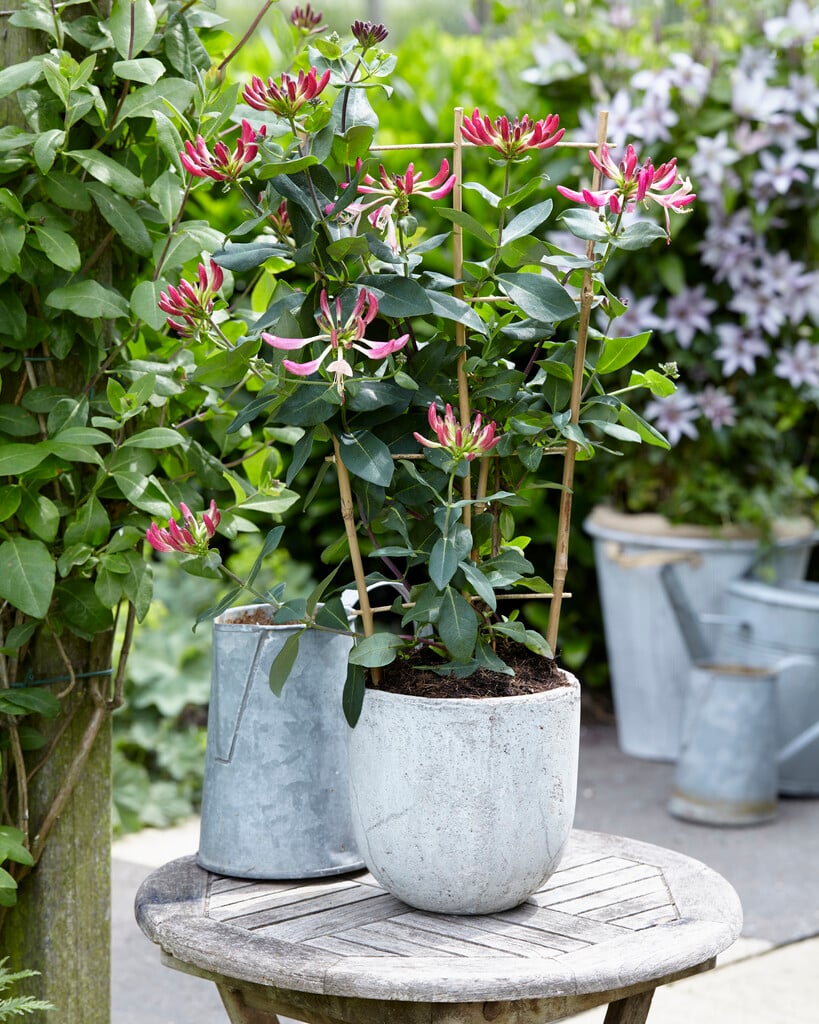Lonicera periclymenum Caprilia Imperial ('Inov86'PBR)
honeysuckle [Caprilia Imperial]
Compact, twining, woody, deciduous climber about 2m tall, with paired, oval mid-green leaves, greyish beneath. Very fragrant, 2-lipped, tubular, creamy-white flowers 5cm long, flushed pink, open from dark red buds in mid and late summer, followed by glossy, red berries
Size
Ultimate height
1.5–2.5 metresTime to ultimate height
2–5 yearsUltimate spread
0.5–1 metresGrowing conditions
Moisture
Moist but well–drained, Well–drainedpH
Acid, Alkaline, NeutralColour & scent
| Stem | Flower | Foliage | Fruit | |
| Spring | Green | |||
|---|---|---|---|---|
| Summer | Cream White Pink | Green | ||
| Autumn | Green | Red | ||
| Winter |
Position
- Full sun
- Partial shade
Aspect
East–facing or North–facing or South–facing or West–facing
Exposure
Sheltered Hardiness
H6Botanical details
- Family
- Caprifoliaceae
- Native to GB / Ireland
- No
- Foliage
- Deciduous
- Habit
- Climbing
- Potentially harmful
- Fruit are ornamental - not to be eaten. Wear gloves and other protective equipment when handling. Pets: Fruit are ornamental - not to be eaten - see the HTA guide to potentially harmful plants for further information and useful contact numbers
- Genus
Lonicera can be deciduous and evergreen shrubs, or climbers with twining stems. The tubular or two-lipped flowers, often very fragrant, are followed by red or black berries
- Name status
Trade
How to grow
Cultivation
Climbing honeysuckles grow best in partial shade but tolerate full sun, and thrives in any fertile, moist but well-drained soil. Ideal for container cultivation. See Honeysuckle (climbing) cultivation
Propagation
Propagate by layering, softwood cuttings, semi-ripe cuttings, leaf-bud cuttings and hardwood cuttings
Suggested planting locations and garden types
- City and courtyard gardens
- Coastal
- Cottage and informal garden
- Patio and container plants
- Wildlife gardens
- Climber and wall shrubs
- Wall side borders
Pruning
Pruning group 11 after flowering
Pests
May be susceptible to honeysuckle aphids, Thrips and glasshouse whitefly
Diseases
May be susceptible to powdery mildews, fungal leaf spot, silver leaf and honey fungus (rarely)
Get involved
The RHS is the UK’s gardening charity, helping people and plants to grow - nurturing a healthier, happier world, one person and one plant at a time.
